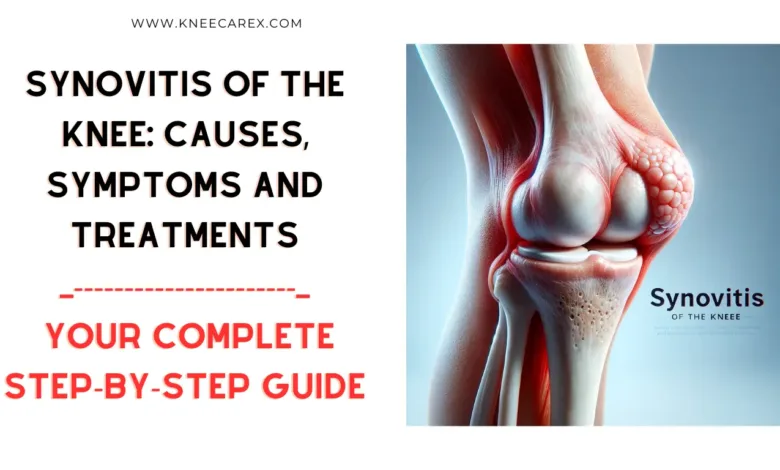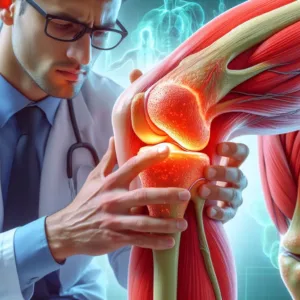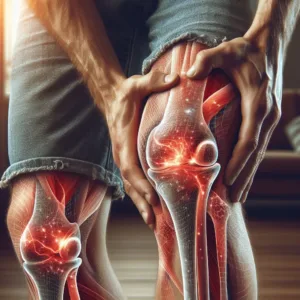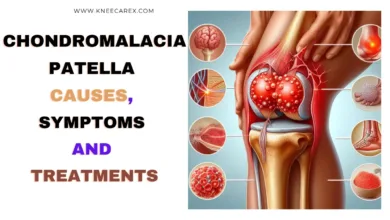Synovitis of the Knee: Causes, Symptoms and Best Treatments

Are you tired of letting knee pain keep you from living your best life? If so, you’re not alone. Synovitis of the knee is a common yet often overlooked condition that affects people of all ages, causing discomfort and limiting mobility. In this article, we’ll delve into the fascinating world of synovitis, exploring its causes, symptoms, and treatment options to help you better understand and manage this troublesome joint affliction.
Contents
- 1 Understanding Synovitis of the Knee
- 2 Anatomy of the Knee Joint
- 3 What is synovitis?
- 4 Common Causes of Synovitis
- 5 Symptoms Indicating Synovitis in Knees
- 6 Diagnosis Methods for Knee Synovitis
- 7 Various Treatment Options for Knee Synovitis
- 8 FAQ’s
- 8.1 How do you treat knee synovitis?
- 8.2 How long does it take to recover from knee synovitis?
- 8.3 Does synovitis ever go away?
- 8.4 What causes chronic synovitis of the knee?
- 8.5 How long does synovitis take to heal?
- 8.6 How do you get rid of synovitis?
- 8.7 Is synovitis permanent?
- 8.8 What happens if synovitis goes untreated?
- 9 Conclusion: Synovitis of the Knee
Understanding Synovitis of the Knee

In addition to conventional treatments like medication and physical therapy, emerging approaches such as biologic therapies and regenerative medicine are showing promising results in managing synovitis of the knee. By targeting specific inflammatory pathways and promoting tissue repair, these novel therapies offer new hope for patients facing chronic or recurrent symptoms.
Anatomy of the Knee Joint
The knee joint is a marvel of biomechanical engineering, comprising the meeting of the thighbone (femur), shinbone (tibia), and kneecap (patella). Encased within this intricate structure are two C-shaped wedges of cartilage called menisci, which act as shock absorbers and provide stability to the joint. The surrounding ligaments, including the anterior cruciate ligament (ACL) and posterior cruciate ligament (PCL), further contribute to the knee’s stability by connecting the bones and limiting excessive movements.
One interesting feature of the knee joint is its synovial membrane, which produces synovial fluid, a viscous liquid that nourishes and lubricates the joint. This fluid plays a crucial role in reducing friction within the knee during movement, allowing for smooth articulation between its components. Moreover, understanding how these intricate structures interact can shed light on conditions such as synovitis and provide insights into their causes and treatment options.
What is synovitis?

The key to managing synovitis lies in understanding its underlying causes and addressing them appropriately. This may involve rest, ice therapy, anti-inflammatory medications, physical therapy, or, in severe cases, surgical intervention. Additionally, adopting lifestyle modifications like maintaining a healthy weight and incorporating low-impact exercises can help alleviate symptoms and prevent the recurrence of this condition. Understanding synovitis not only empowers individuals to seek proper treatment but also highlights the significance of joint health maintenance for overall well-being.
Common Causes of Synovitis
Synovitis, the inflammation of the synovial membrane surrounding the knee joint, can be triggered by a variety of factors. One common cause is overuse or repetitive stress on the knee joint, often seen in athletes or individuals with physically demanding jobs. Additionally, trauma to the knee, such as a sudden impact or injury, can lead to synovitis, the body’s natural response to healing. In some cases, underlying medical conditions like rheumatoid arthritis or gout can also contribute to the development of synovitis in the knee.
Furthermore, bacterial or viral infections have been identified as potential culprits behind synovitis. These infections may directly affect the knee joint or enter through other parts of the body and travel to the knees via the bloodstream. It’s essential for healthcare providers to thoroughly evaluate patients with suspected synovitis to identify and address these underlying causes effectively. Understanding these diverse triggers can help individuals take preventive measures and seek appropriate treatment for their condition.
Symptoms Indicating Synovitis in Knees

Another key indicator of synovitis in the knees is a noticeable increase in pain during physical activity or weight-bearing movements. If you find that your knee pain worsens when you walk, climb stairs, or engage in exercise, it’s important to seek medical attention for a proper diagnosis. Additionally, you may also experience a sensation of grinding or clicking within the knee joint during movement, indicating potential damage caused by inflammation. Being aware of these symptoms can help you recognize and address any potential issues with synovitis early on for effective treatment and management.
Diagnosis Methods for Knee Synovitis
Diagnosing knee synovitis requires a careful and comprehensive approach utilizing various diagnostic methods. One of the most common techniques used is imaging studies, including X-rays and MRI scans, which can help visualize any abnormalities in the knee joint, such as inflammation or swelling of the synovial lining. Additionally, ultrasound may also be employed to assess the extent of synovial thickening and joint effusion, providing real-time images that can aid in an accurate diagnosis.
Best Radiologists for x-rays and ultrasounds near You
Another important diagnostic method for knee synovitis is arthrocentesis, a procedure where a small sample of the synovial fluid is withdrawn from the affected joint using a needle. This fluid can then be analyzed for signs of inflammation, infection, or other underlying conditions causing the synovitis. By utilizing these various diagnostic methods in combination, healthcare providers can effectively identify and evaluate knee synovitis to devise appropriate treatment strategies tailored to each patient’s specific condition.
Various Treatment Options for Knee Synovitis

Another treatment option gaining attention is prolotherapy, which involves injecting a solution into the affected ligaments or tendons to stimulate the body’s natural healing process. This approach is particularly appealing to those seeking non-surgical solutions and may provide long-lasting relief for individuals with chronic knee synovitis. Additionally, physical therapy and personalized exercise programs are increasingly recognized as effective methods for managing knee synovitis by enhancing joint strength and reducing inflammation through targeted rehabilitation exercises.
FAQ’s
How do you treat knee synovitis?
When it comes to treating knee synovitis, a multi-faceted approach is often employed to alleviate symptoms and address the underlying cause. One common method is rest, which allows the inflamed synovial membrane in the knee joint to settle down and heal. Coupled with rest, icing the affected area can help reduce swelling and provide pain relief. Physical therapy may also be recommended to strengthen the muscles around the knee, improving stability and reducing stress on the joint. In some cases, anti-inflammatory medication or corticosteroid injections may be prescribed to reduce inflammation further and manage pain.
How long does it take to recover from knee synovitis?
Recovery from knee synovitis can vary greatly from person to person, depending on the severity of the condition and the individual’s overall health. In mild cases, where rest, ice, and over-the-counter pain relievers may suffice, recovery can take a few weeks. However, more severe cases may require physical therapy or even surgical intervention, extending the recovery timeline to several months. Patients need to follow their doctor’s recommendations closely and be patient with the healing process.
Does synovitis ever go away?
The question of whether synovitis ever goes away is one that many individuals living with this condition may ponder. Synovitis, which involves inflammation of the joint lining (synovium), can be a persistent and recurrent issue for some patients. However, the good news is that with appropriate treatment and management, synovitis can indeed improve and, in some cases, completely resolve. It’s essential to note that the effectiveness of treatment largely depends on the underlying cause of synovitis. In cases where it is secondary to another condition, such as rheumatoid arthritis or injury, addressing the root cause through targeted therapies may lead to the resolution of synovitis over time.
What causes chronic synovitis of the knee?
Chronic synovitis of the knee, a condition characterized by persistent inflammation of the synovial membrane, can be caused by various factors. One common cause is repetitive trauma or injury to the knee joint, leading to continuous irritation and inflammation of the synovium. In addition, conditions such as rheumatoid arthritis and osteoarthritis can also contribute to chronic synovitis by triggering an autoimmune response that perpetuates inflammation within the knee joint.
How long does synovitis take to heal?
The duration for synovitis to heal can vary depending on the cause and severity of the condition. In general, mild cases of synovitis may resolve within a few weeks with rest, ice therapy, and nonsteroidal anti-inflammatory drugs (NSAIDs). However, more severe cases may require several months of treatment, including physical therapy or corticosteroid injections.
How do you get rid of synovitis?
Dealing with synovitis can be a challenging and painful experience, but there are several effective ways to alleviate its symptoms and promote healing. One of the key methods for managing synovitis is through rest and proper elevation of the affected joint. This can help reduce inflammation and relieve pain, allowing the body to heal itself naturally. Additionally, physical therapy exercises can play a crucial role in strengthening the muscles around the affected joint and improving flexibility, which can ultimately decrease pressure on the inflamed synovium.
Is synovitis permanent?
Synovitis, an inflammation of the synovial membrane that lines the joints, is a condition that can cause significant discomfort and reduced mobility in affected individuals. One common concern among those diagnosed with synovitis is whether it is a permanent condition. The good news is that synovitis is typically not permanent and can be effectively treated with appropriate medical intervention. However, it’s important to note that the duration of treatment and recovery may vary depending on the underlying cause and severity of the inflammation.
What happens if synovitis goes untreated?
If left untreated, synovitis can lead to a series of serious complications that can significantly impact a person’s quality of life. One potential consequence is the progression of synovitis to chronic inflammation, which can result in irreversible damage to the joint tissues. This damage may ultimately lead to conditions such as arthritis, where the cartilage and bone within the joint deteriorate over time, causing pain and limited mobility.
Conclusion: Synovitis of the Knee
In conclusion, managing and preventing knee synovitis requires a comprehensive approach that focuses on both symptom relief and addressing the root causes. From a management standpoint, implementing targeted physical therapy and exercise routines can help strengthen the muscles around the knee joint, thereby reducing stress on the affected area. Additionally, incorporating anti-inflammatory foods into one’s diet and maintaining a healthy weight can help alleviate symptoms and prevent flare-ups.




